#BLMutah
Explore tagged Tumblr posts
Photo





Get to know your public lands in Utah
This week of the #MyPublicLandsSummer, take a trip through the state of Utah! From spectacular red-rock canyons and roaring rivers to high mountain peaks and expansive salt flats, the BLM in Utah is unparalleled in scenic beauty.
The BLM in Utah has an abundance and diversity of recreational opportunities and stunning landscapes that attract visitors from across the state, region, country and world. From mountain biking Moab to canyoneering in the San Rafael Swell; river running Westwater Canyon to OHV riding Little Sahara; driving Nine Mile Canyon to hunting in the Henry Mountains, BLM-Utah provides countless opportunities to explore 23 million acres.
In addition to being a good steward of your public lands, please help others to be respectful and responsible by setting a good example.
Be sure to contact your local BLM office for more information or suggestions. https://www.blm.gov/office/utah-state-office
#public lands#MyPublicLandsSummer#adventure#summer#recreation#hiking#biking#boating#fishing#hunting#ohv#kayaking#outdoors#mypubliclands#blmadventures#utahlife#BLMutah#utah
131 notes
·
View notes
Text
if you don't know
Somewhere on the #CottonwoodCanyonRoad in #Utah #GrandStaircaseEscalante #NationalMonument #StormHour @StormHour #2WonTour @visitUtah @Utah @UtahGov @BLMUtah @GrandStairATV @ThePhotoHour @DailyNatureshot @EnjoyNature

If you don’t know where you are gong, any road will get you there. ~ Lewis Carroll ~
Somewhere along the Cottonwood Canyon Road in Utah.
you might also like
Monsoon Skies of the Southwest
impressions of the American Southwest
images from my American Road Trips including Route 66
us National Monuments or us National Parks
more landscapes from the United States
more images from Utah
… read more about…
View On WordPress
#2010#clouds#Cottonwood Canyon Road#Grand Staircase Escalante#Monsoon Skies#mountains#us National Monuments#us Southwest
0 notes
Photo

@BLMUtah: Ken’s Lake, south of #Moab, is a great place to spend time fishing. You can expect to catch #largemouthbass, #rainbow #trout, #bluegill, #browntrout, #channelcatfish, or #greensunfish. The reservoir is a great place to beat the heat! Photo: BLM #DiscoverBLMUT https://t.co/iowTqpyMHy
0 notes
Photo

Great photos from today’s #SaveOnaqui rally by @jamibollschweilerphotography • For those who couldn’t join the rally in person please take part in the digital sit-in. Post, share, tweet and tag #SaveOnaqui @freewildhorses @USInteriors @Mypubliclands (On Twitter @interior @BLMUtah @BLMNational) (at Salt Lake City, Utah) https://www.instagram.com/p/Bv5NUqhnnnT/?utm_source=ig_tumblr_share&igshid=1hyuzxis9504j
0 notes
Text
BLM Beginning Second Year of Conger Horse Gather, Study
New Post has been published on http://lovehorses.net/blm-beginning-second-year-of-conger-horse-gather-study/
BLM Beginning Second Year of Conger Horse Gather, Study
The Bureau of Land Management (BLM) Fillmore Field Office is planning to begin the second year of research wild horse gathers in the Conger Herd Management Area (HMA), located west of Delta, Utah, on Nov. 28.
“This gather is in year two of a research study that is being conducted on wild horse behavior and ecology, said BLM West Desert District Wild Horse Specialist Trent Staheli. “It will examine the behavioral effects of gelding, population dynamics, fertility, reproductive rate, recruitment rate, age-specific survival and mortality, habitat selection, movements, and habitat range among other things.”
The researchers are working with the United States Geological Survey Fort Collins Science Center and Colorado State University to study elements at both the individual and population levels within the Conger Herd Management Area.
The public is welcome to observe daily operations through BLM-escorted tours provided that animal, staff, and observer safety are not jeopardized and gather operations are not disrupted. Observers must provide their own transportation, water, and food. Public restrooms will not be available. The BLM recommends weather appropriate footwear and neutral-colored clothing. Binoculars and high-clearance four-wheel-drive vehicles are-strongly recommended.
Those interested in participating should meet at the Border Inn Gas Station at the junction of Hwy 6 and 50 on the Utah-Nevada state line, 88.6 miles west of Delta, Utah, where tours will depart at 6:30 a.m. MST. Daily adjustments to this schedule and specific details will be recorded daily on the BLM gather hotline at 801/539-4050.
Visitors and observers to the gather area should be aware that low-flying helicopters will be used as part of the operation. Use of flying unmanned aerial vehicles (drones) near the Conger Mountain ranges north of Highway 6 and 50 will be prohibited during the gather. Brief road closures might also be needed to allow for horse movement during gather operations.
All horses gathered will be shipped to the Delta Wild Horse Facility. The facility will remain closed Nov. 27 through Dec. 18 to allow the researchers to study the horses before they are returned to the range.
Gather updates and information will be posted at go.usa.gov/xnB4g. Updates are also available via Twitter by following @BLMUtah or searching #CongerGather.
An environmental assessment is available via the BLM’s planning documents website at goo.gl/pNIggw. More information on the population control research project is available from the BLM’s Fillmore Field Office at 435/743-3100.
0 notes
Photo

Lovin" The View! #landscape #utah #photography #bucketlist #weekendinspiration #desert #canyons #nature #wildflowers #scenic #getoutdoors #getoutside #hiking #biking #mountainbiking #mtb #horsebackriding #explore #mypubliclands #nationalconservationlands #findyourpark #SeeBLM #BLMutah
#landscape#utah#photography#bucketlist#weekendinspiration#desert#canyons#nature#wildflowers#scenic#getoutdoors#getoutside#hiking#biking#mountainbiking#mtb#horsebackriding#explore#mypubliclands#nationalconservationlands#findyourpark#SeeBLM#BLMutah
0 notes
Text
West Desert Wilderness Survey
Story by Kim Crumbo, first printed in the Winter 2014 Utah Sierran
November weather is unpredictable, but we took a chance on our Sierra Club-sponsored Veteran’s Day celebration and wilderness inventory/monitoring adventure. Our reward turned into five glorious days of sunshine and perfect night skies in the wilds of Utah’s southern Great Basin.
WILDERNESS FOR THE FUTURE
Earlier this year, the Bureau of Land Management (BLM) completed an inventory of Lands with Wilderness Characteristics (LWC) for the Cedar City Field Office (Iron and Beaver Counties). The BLM inventory resulted in11 units (182,880 acres) identified as having wilderness characteristics, or less than 40 percent of 494,000 proposed by the Utah Wilderness Coalition (UWC) and included within America’s Red Rock Wilderness Act <http://www.opencongress. org/bill/113-s769/text>.
Over 160 mountain ranges and 90 basins comprise the Basin and Range Province, an expanse of 200,000 square miles stretching from Utah’s Wasatch Mountains on the east to the Sierra Nevada Range on the west; and from the Snake River Valley on the north to the Colorado River drainage system on the south. Precipitation falling in Utah and Nevada’s unique Great Basin, never reaching the sea, flow or trickle into Sevier Lake, Great Salt Lake, the Humboldt Sink, or other landlocked wetlands.
Our hardy 10-person crew’s mission, evaluate the wilderness qualities of four Utah mountains, filled up our five-day outing into areas selected or rejected by the BLM as lands with wilderness character.
SAN FRANCISCO MOUNTAINS
Our first assignment, briefly explore the 9,960-ft San Francisco Mountain in proposed wilderness, required 4X4 travel along the cherry-stemmed route to Frisco Peak’s radio towers and hang-glider launch ramp, all excluded from our wilderness proposal. While the development was conspicuous close up, the mountain’s rugged terrain and dense forest and woodlands and rugged mountain range largely concealed this visual intrusion and afforded ample solitude throughout most of the 45,390-acres..
Later, we briefly investigated the Central Wah Wah Mountains, a stunning massif of regal beauty, wildness and solitude. To its credit, the BLM agreed that the area possessed ample wilderness characteristics.
INDIAN PEAK MOUNTAINS/TWIN PEAKS PROPOSED WILDERNESS
Later, we climbed a ridge leading north to the 9,760-foot Indian Peak and overlooking an 11,000-acre roadless area that, by all appearances, qualified as wilderness. The ridge we hiked on continues into a state Wildlife Management Area that includes the highest point in this range, Indian Peak, one hundred feet higher than Frisco Peak in the San Francisco Mountains. The apparent wildness of the expansive Indian Peak Range belies a complex patchwork of private, state, and federal land that greatly complicates effective protective management of the areas that possess wilderness characteristics.
The Indian Peak Wildlife Management Area, managed by the State of Utah, was once part of the Piute Indian Peak Reservation. By the 1930’s, the area was then purchased by the Utah Division of Wildlife Resources and, in 1958, turned into a game preserve with elk being the primary focus. Elk were introduced into the area in the 1940’s while the Wildlife Management Area designation offer some level of protection and outstanding opportunities for hunting throughout the Indian Peak Range.
The spectacular, 9,446-foot high Twin Peaks overlook an expansive, rugged 25,687- acre roadless area of dense woodlands
and forests, and outstanding opportunities for wildlife viewing, hunting, hiking, and horseback riding. Never-the-less, the BLM determined that both areas lack solitude and opportunities for a primitive recreation. “The high elevation (>8000’) areas of the unit provide scenic vistas of Hamlin and Pine Valleys,” but, according to the agency, “these opportunities are common in the Great Basin ecoregion.” Well, exquisite paintings might seem commonplace to a jaded visitor to our National Gallery of Art, but that does not diminish each masterpiece’s beauty and value. In any event, spectacular scenery contributes to, not detracts from, an area’s wilderness characteristics. What is not common in the Cedar City Field Office lands is designated wilderness. There is none.
MOUNTAIN HOME RANGE
The southern, expansive (35,227 acres) portion of this stunning roadless region consists of high, alpine ridgelines, rough terrain, and extensive forest and woodlands and possesses all the attributes of qualities described in the Wilderness Act. At this final destination, our crew found that wildlife abounds, as do opportunities for solitude and a primitive and unconfined recreation. Unfortunately, the BLM determined that this impressive wildland lacked the wilderness qualities described in the Utah Wilderness Coalition’s extensive wilderness surveys and extolled in the current version of America’s Red Rock Wilderness Act.
From the high windswept Mountain Home Range ridges, Great Basin National Park’s 13,000-foot Wheeler Peak, with its 11 species of conifer trees, 71 species of mammals, 18 species of reptiles, 241 species of birds, and over 800 species of plants, dominates our vista but not our imagination. The Great Basin is an American treasure, and many of its mountains and valleys qualify and deserve the assurances wilderness designation affords wild nature.
BLM welcomes comments on their wilderness inventory at any time. Learn more by going to BLM’s web site (provide website link and address for BLM email address) The BLM anticipates release of the Resource Management Plan and Draft Environmental Impact Statement will be released late winter or early spring of 2014 as the Sierra Club and most of America’s conservation community initiates celebration of the 50th anniversary of the Wilderness Act. Before us lies our opportunity to continue the American odyssey of protecting wild nature for its intrinsic beauty, and for its ecologic and inspirational value for current and future generations.
Thanks to the intrepid volunteers who joined us for this exploration, but particular thanks must go to wilderness exploration veteran Vicky Hoover who kindly operated the canteen during the outing.
0 notes
Photo
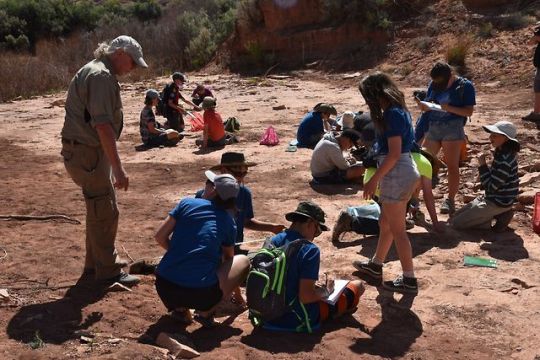
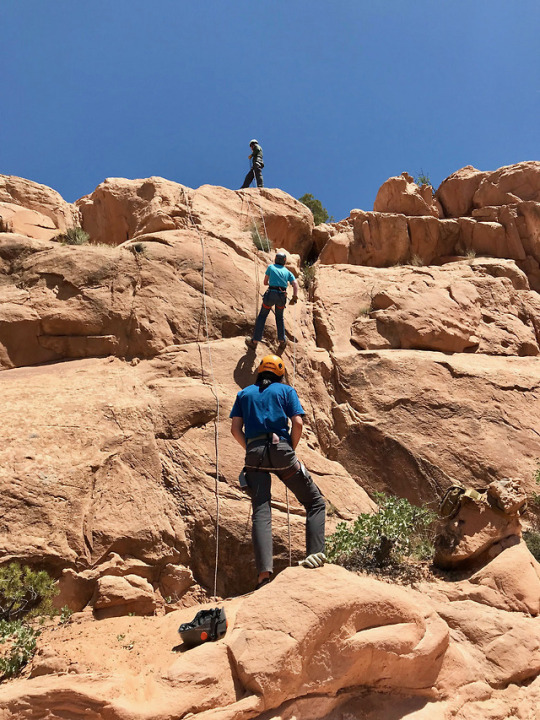
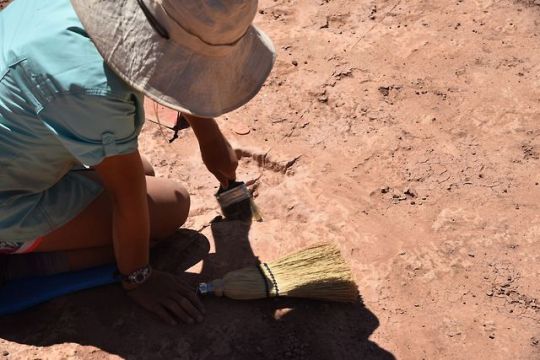
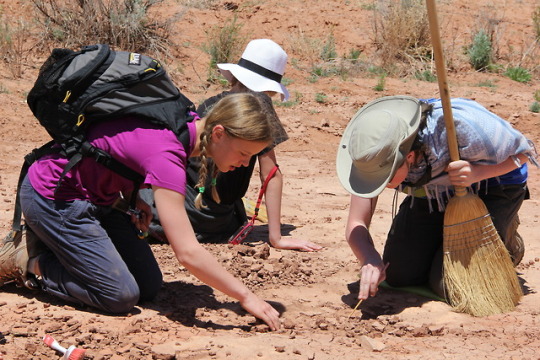
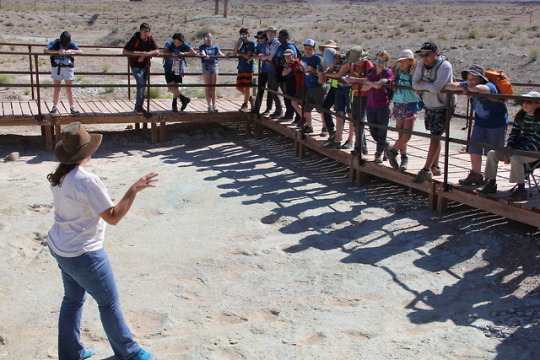
BLM Utah hosts Paleo Camp 2018
In May, 25 students from the Salt Lake Center for Science Education, a science technology, energy and mathematics charter school in Salt Lake City, spent four days studying fossils and collecting data in southeastern Utah with BLM geologists and paleontologists. The students road-tripped their way from the Cleveland-Lloyd Dinosaur Quarry, where geologist Mike Leschin showed them the world's largest concentration of Allosaurus fossils, to sunny Moab, where they toured the Mill Canyon Tracksite.
The students also spent an afternoon at a remote track site uncovering and documenting theropod tracks with paleontologists Dr. Greg McDonald, ReBecca Hunt-Foster and Brent Breithaupt. The data collected by the students will be used by the paleontologists for ongoing monitoring and research activities. Besides discovering dino tracks, the students rappelled down red rock canyons, kayaked and caught crayfish at BLM's Ken's Lake Recreation Area.
Other camp highlights included sunset at Dead Horse Point State Park and camping under the stars at BLM's Lone Mesa campground. The chaperones included BLM staff, volunteers, Salt Lake Center for Science Education teachers and vice-principal.
Next year, BLM Utah and the Salt Lake City School District hope to provide both paleontology and archaeology camps to Utah seventh graders. Many thanks to the awesome kids, teachers and the Price and Moab Field Offices for making the Salt Lake Center for Science Education Paleo Camp 2018 a huge success!
#utah#BLMutah#paleo#paleontology#youth#science#STEM#education#youth education#research#recreation#bureau of land management
49 notes
·
View notes
Photo




Price Field Office hosts fall break volunteer project
The Price Field Office hosted the University of Utah Identity and Environmental Exploration Alternative Fall Break this October. All of the students that participated in the project are first-generation college students and interested in an opportunity to engage in environmental stewardship, as well as explore and enrich their own educational journeys. The program provides students with an opportunity to engage in volunteerism and experiential learning through their Fall Break.
The day began with a safety talk to prepare the students for the day’s work. After this talk, the PFO staff in attendance –Outdoor Recreation Planner Ben Kraja, Outdoor Recreation Planner Myron Jeffs and Acting Assistant Field Manager Jake Palma – told brief stories about the San Rafael Swell and hiked with the students up to a single dinosaur track embedded in stone. While at the dinosaur track, Ben shared Leave No Trace Principles of how to enjoy the site without disturbing the resource for future visitors.
University of Utah Alternatives Breaks Program Coordinator Lea Karabegovic enthused, “We are so appreciative for the opportunity we had to work with the Price BLM Field Office. Our group of students had an incredible time participating in service work to help restore the Swinging Bridge Campground. It was truly meaningful to gain a much better understanding of how BLM lands are managed, and all that they have to offer. The group really enjoyed engaging in thoughtful discussions about land management and use, methods of dealing with invasive species, as well as learn more about the rich cultural and geological history of the San Rafael Swell.”
The volunteer project started at the Equestrian Campground, near the San Rafael River and Swinging Bridge. The staff worked with the volunteers to rebuild roughly 200 feet of downed fence. During the rebuild, BLM staff chatted about why the fence is necessary, the benefits of outdoor recreation, and the overall mission of the BLM. Once the fence rebuild was complete, we switched to picking up trash and other maintenance at Equestrian and Swinging Bridge Campgrounds, including raking out overgrown vegetation and clearing brush away from the campsite identification signs.
"Any volunteer project that benefits public lands, includes an educational component and provides youth an opportunity to have a public lands experience is successful. This project was no exception. The students were enjoyable to work with and they did a great job", says Myron.
In addition to providing recreation benefits to the public, the project was a rewarding experience for students and BLM staff. Ben Kraja explains, “This project was special to me because I am also an alum of the University of Utah and a first generation college student. It was great to chat about public land management with these students, because a career path in land management isn’t widely talked about with a lot of first generation students. Having the opportunity to relate to them and answer their questions was an experience I hope to repeat with future University of Utah Alternative Fall Break projects.”
Story and photos by Ben Kraja, Price Field Office Outdoor Recreation Planner.
#utah#BLMutah#outdoors#volunteering#partnership#university of utah#fall#autumn#STEM#conservation#environmental stewardship#environment#volunteers#bureau of land management
64 notes
·
View notes
Photo






Utah’s Nature High Summer Camp
Story by Beth Wineke, University of Utah Hinckley Institute of Politics Intern. Photos courtesy of Sierra Hellstrom, US Forest Service.
Nature High Summer Camp is a week-long learning experience for high school youth in Utah. Students are introduced to a day in the life of a natural resource professional by spending time with professionals in the field and learning the ins and outs of land management.
The camp began in 1991, and is now run through a cooperative partnership between Utah State University Extension 4-H, Bureau of Land Management, Bureau of Reclamation, Natural Resources Conservation Service, US Geological Survey, US Forest Service and Snow College. This partnership has helped to enrich the experiences of many high school students at Nature High Summer Camp throughout the last few decades.
The goal of the camp is to help high school students learn more about natural resource and public lands management through engagement in hands-on activities and interactions with professionals. Students learn about possible careers and ways they can work with the natural world in everyday life. Another goal of this camp is to encourage women and minorities to pursue careers in the sciences.
Students of all backgrounds gain respect for natural resources through this opportunity so that their unique perspectives may be utilized in order to enhance equitable management and planning. The Land Use Scenario, in particular, is an activity that allows campers to demonstrate what they have learned and use their unique individual skills to develop a land use plan.
This year, 22 students from all over Utah participated in the camp. Each day, campers worked with different natural resource experts and learned about hydrology, soil science, forestry, aquatic and wildlife biology, and rangeland science. Additionally, local land users presented as guest speakers in the evenings. Through team games, artwork, service projects and other leadership activities, youth from all backgrounds learned more about each other and expressed their individuality.
Pre- and post-evaluations showed a positive change in behavior and attitude for the students, with 100% students rating the camp "high" or "very high" in terms of educational experience. Additionally, interest in natural resources and careers and knowledge of these fields increased significantly.
Special thanks to the agencies and organizations who partner with the BLM to sponsor Nature High Summer Camp, and to all those who have participated! BLM Utah is grateful for your support.
#utah#BLMutah#youth#education#outdoor education#learning#STEM#women in STEM#natural resources#science#outdoors#learn#land management#bureau of land management
49 notes
·
View notes
Photo
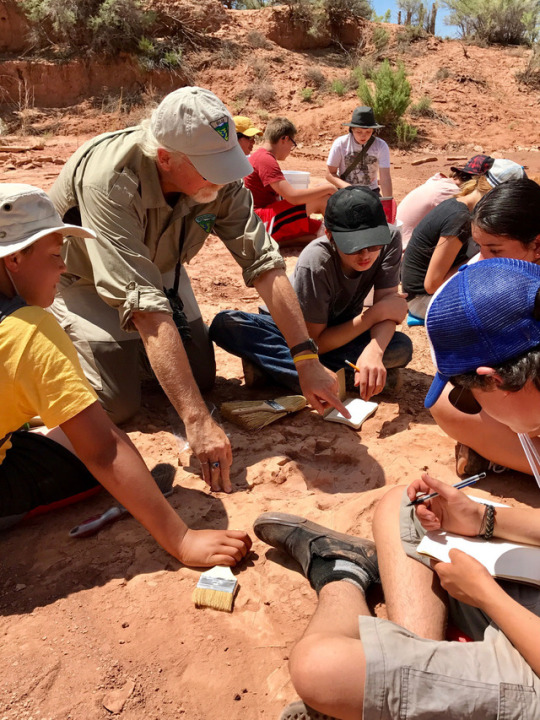
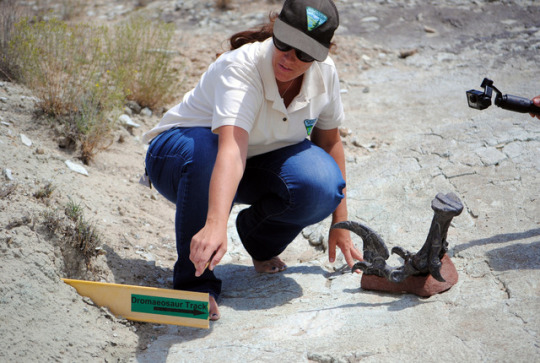
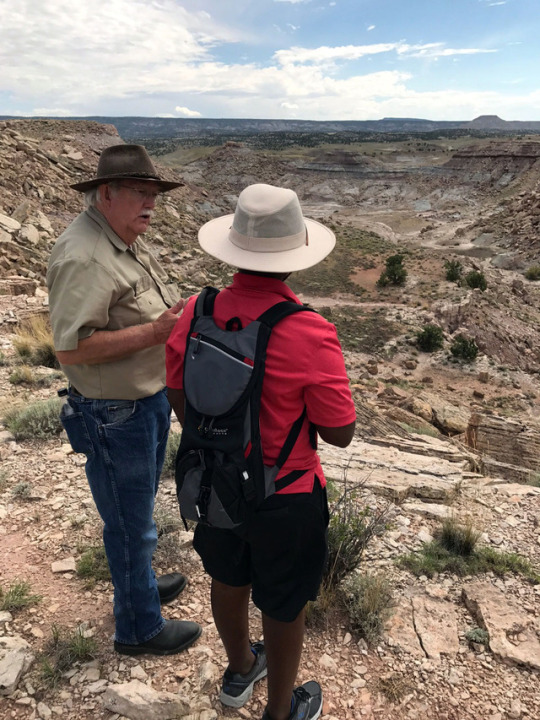
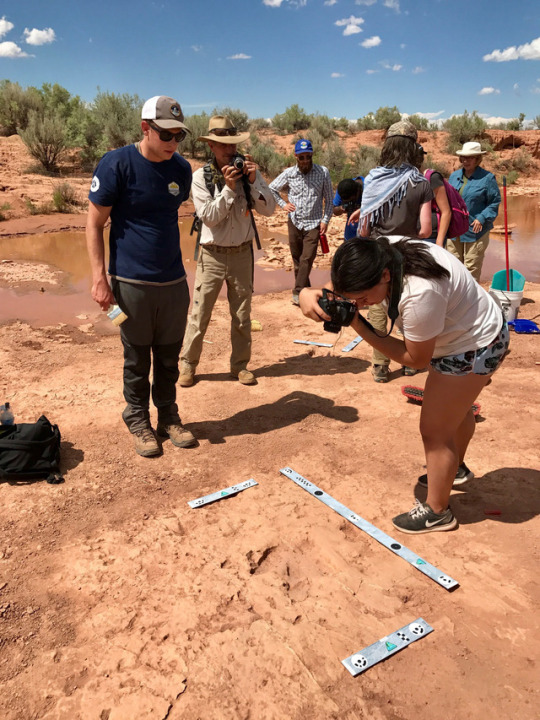
#NationalFossilDay: Interagency Team launches new paleo camp
On August 7-11, BLM-UT and Salt Lake Center for Science Education teamed up to teach youth about BLM-Utah's world-class paleontological resources and recreation sites.
When Regional Paleontologist Greg McDonald was hired at the Utah State Office last year, dino-sized projects immediately began to evolve. One of his first ideas was to create a week-long Paleo Camp for middle school students. He reached out to a STEM-based charter school in Salt Lake City that the BLM-Utah youth program was already familiar with: the Salt Lake Center for Science Education (SLCSE). The school’s outdoor exploration instructors, Cavett Eaton and Dr. Sydney Stringham, agreed to help pilot the new camp.
The BLM-Utah program leads and SLCSE teachers collaborated to develop a unique curriculum that emphasized two themes: BLM-Utah’s world-class paleontological resources and recreation sites. The team identified campsites, interpretative sites, age-appropriate challenge and STEM activities and learning goals.
In June, BLM-Utah youth program state lead Jeanette Matovich, attended a National Association for Interpretation training course, where she presented on the SLCSE Paleo Camp and recruited three young classmates, who happened to be trained wilderness first responders, to help mentor students and keep the team safe. The Essential Interpretation Skills Course added unexpected, exponential value because camp would not have been camp without enthusiastic BLM interns Ryan Ashcraft, Marissa Sly and Alex Studd-Sojka. The SLCSE teachers recommended that the BLM continue to enhance its youth education programs by recruiting skilled mentors from the National Association for Interpretation’s training programs.
SLCSE Paleo Camp took place August 7-11, 2017. The first stop was Cleveland-Lloyd Dinosaur Quarry (CLDQ). Price Field Office Geologist Mike Leschin led the students on a tour and discussed the "Jurassic Mystery" about why there are so many predators- especially allosaurs- at CLDQ. From there, the group traveled to the Mill Canyon Dinosaur Tracksite, where Canyon Country District Paleontologist ReBecca Hunt-Foster showed the group various trace fossils, including theropod, ornithopod and sauropod dinosaur tracks.
The highlight of SLCSE Paleo Camp was working with BLM-WY Regional Paleontologist Brent Breithaupt and Geographer Neffra Matthews at the Mail Station Tracksite south of Moab, UT. The BLM experts showed the students how to clean off dinosaur tracks, and then measure and photograph them using photogrammetric techniques. Neffra entered the data into a program that created 3D images of the tracks, with the help of coworker Christopher Anderson-Tarver, while Brent showed the students how to calculate dinosaur hip height and stride length from their measurements. GIS intern Andy Eaman assisted the groups with cleaning the surface and helping the students.
Because the project was intended to be an applied exercise, the students collected primary data that the BLM will use for management and interpretation purposes. This was some of the first scientific data collected at this Early Jurassic tracksite and will help provide insights into the life and times of the prehistoric animals that once roamed through the ancient Utah.
Between paleo sessions, the kids took advantage of Utah’s awesome recreation opportunities. They hiked, rappelled down red rock cliff faces and went kayaking at Ken's Lake. At the closing awards ceremony, Greg handed out signed "Dinosaur Tracker" certificates and Junior Ranger Paleontology pins.
The team is already gearing up for the next SLCSE Paleo Camp, scheduled for May 16-18, 2018 at Lone Mesa Campground near Moab, UT.
Please enjoy our #SLCSEPaleoCamp Flickr Album and a YouTube video documenting the event!
Story by Jeanette Matovich Shackelford, BLM-Utah Youth Program State Lead. Photos by Jeanette Matovich Shackelford, BLM-Utah Youth Program State Lead; Cavett Eaton and Dr. Sydney Stringham, Outdoor Exploration Instructors, SLCSE; Alexandra Studd-Sojka, Wild and Scenic Rivers Intern, BLM-CA; Neffra Matthews, BLM-National Operations Center.
#nationalfossilday#paleontology#paleo#fossils#outdoors#science#STEM#youth#Youth in STEM#fossilday#bureau of land management#partnerships#utah#BLMutah
82 notes
·
View notes
Photo






Earth Connections Camp for Tribal Youth Connects STEM and Cultural Traditions
Story by Jeanette Shackelford, Youth Program State Lead. Photos by BLM Utah and the Bureau of Reclamation.
In June, Utah's Earth Connections Camp welcomed about 45 American Indian youth for 2 full days of fun and learning in Salt Lake City. The day camp for American Indian youth emphasizes STEM and traditional cultural activities taught by tribal and agency experts. BLM-Utah is a founding partner along with the Utah State Board of Education, and has helped direct camp for the past five years.
The students visited outdoor learning stations featuring hydrology, Utah Tribal history, dam engineering, ethnobotany, health and medical sciences, soils, and flute-playing. At Thanksgiving Point Institute, the youth built circuits that powered robots capable of coloring pictures, and even controlling computers.
This year, the BLM-Utah's Associate State Director, Anita Bilbao, was the keynote speaker. In her address, Bilbao encouraged Earth Connections Campers to embrace their culture, never stop asking questions, and say yes to new experiences!
112 notes
·
View notes
Photo





Thanks for joining us during National Photography Month!
This May, we celebrated National Photography Month with photos from #yourpubliclands, tips from the experts, and some travel inspiration for your next trip to BLM-managed lands. Check out our Instagram for a recap of National Photography Month, and follow for more!
Photos courtesy of Jeff Sullivan, Richard Bednarski, John D’Onofrio, and Raymond Lee.
#bureau of land management#national photography month#photography#instagram#photos#nature#get outside#travel#inspiration#nevada#BLMnevada#yourpubliclands#mypubliclands#utah#new mexico#BLMutah#BLMnewmexico
266 notes
·
View notes
Photo



#TravelTuesday: Utah’s Gooseberry Mesa and Hurricane Cliffs!
Gooseberry Mesa and Hurricane Cliffs trails are located in southern Utah’s red rock country. Views from the mesa rims along these trails are spectacular. To the north are massive sandstone sentinels of Zion National Park. Spread out below the west rim is a panorama of colorful desert mesas and water carved canyons.
These trails are designed to provide technically challenging mountain bike opportunities. Single track and slickrock wind across the mesa top in a series of interconnected trails providing a unique setting that will provide a high quality experience to all types of mountain bikers.
May marks National Bike Month. Each week throughout the month of May, the BLM will showcase public lands with premier biking opportunities.
Photos by BLM and courtesy of Leslie Kehmeier, Mapping Manager, International Mountain Bicycling Association.
#bureau of land management#traveltuesday#travel tuesday#biking#mountain biking#national bike month#recreation#get outside#getoutdoors#photography#nature#public lands#trails#utah#BLMutah
65 notes
·
View notes
Photo



BLM-Utah, South Dakota School of Mines and Technology, and dinosaur fossils
Forty years ago, the Bureau of Land Management (BLM) in Utah constructed two temporary buildings to protect Jurassic fossil beds at the Cleveland-Lloyd Dinosaur Quarry (CLDQ) near Price, Utah. Since then, weathering and natural geological processes have made noticeable inroads on the conditions inside the buildings impacting the exposed fossils on view to visitors. The in situ bones are a valuable resource for research, education and public viewing, and BLM paleontologists sought advice from Sally Shelton. Shelton is a museum conservation expert at the Museum of Geology, South Dakota School of Mines and Technology (SDSMT), and also teaches a Paleontological Resources course at SDSMT.
Sally saw this as an opportunity to provide her students with a real-world field experience, so Sally and six students drove from Rapid City, South Dakota to Price, Utah to spend time onsite with quarry experts and offer improvements to the long-term protection of the fossils at the CLDQ. A media team from the Utah State Office joined the group to film and interview the students, as part of a short film about the quarry and the SDSMT’s unique project at CLDQ.
Upon return to Rapid City, the class began working together to produce a written report detailing their recommendations for CLDQ and Fossil Point- where they had stopped on the way to the Moab area. Partnerships are vital to managing sustainable, working public lands, and BLM-Utah looks forward to sharing the class’ professional report and the video of the experience later this year!
For more information about the BLM’s paleontology program click here.
#paleontology#fossils#dinosaur#dinosaurs#Utah#BLMUtah#south dakota#science#youth#careers#STEM#bureau of land management
48 notes
·
View notes
Photo

Happy #NationalPetDay! Get Outside with Your Pet on Your Public Lands
Take your pet to Onion Creek Trail (managed by the Bureau of Land Management in Utah)- a 22.9 mile trail located near Moab. The trail features a river and offers a number of activity options for you and your pet year-round.
Photo by Ryan Sutherland, BLM Utah.
#pets#Bureau of land management#utah#BLMutah#visitutah#trails#recreation#dogs#Moab utah#moab#outdoor recreation
79 notes
·
View notes